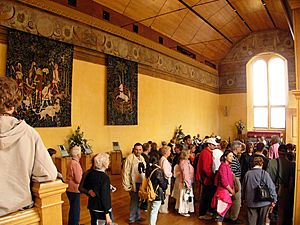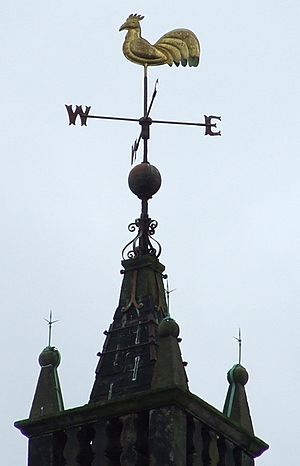Valentine Jenkin facts for kids
Valentine Jenkin or Jenkins was a talented English artist who worked as a decorative painter in Scotland during the 1600s. He was known for making buildings look beautiful with his paintings.
He was called an "English man" in records of his work. He also became a burgess of Glasgow, which meant he was an important citizen of the city.
Contents
Painting in Glasgow
In 1627, Valentine Jenkin worked on the steeple of the Glasgow Tolbooth. He painted the large globe and the weather vane that sat on top of the steeple. This made the Tolbooth look grand and impressive.
Art at Stirling Castle
Valentine Jenkin did a lot of important work at Stirling Castle, a famous Scottish castle.
Decorating the Chapel Royal
In 1628, Jenkin and his team redecorated the Chapel Royal at Stirling Castle. They refreshed old paintings from 1594, both inside and outside the chapel.
Inside the chapel, Jenkin painted a special border called a frieze. This frieze had designs of leaves, fruit, and medallions. Even today, you can still see parts of this painted frieze in the chapel.

Painting the Palace Rooms
Jenkin also signed two agreements in 1628 to paint many rooms in the palace part of Stirling Castle.
Outside the Palace
On the outside of the palace, he painted and gilded (added gold details to) the royal initials and crowns. He also painted the window grills, called yetts, with red oil paint. The gatehouse and its coat of arms were painted in the same way.
Inside the Palace
Inside the palace, Jenkin painted the window shutters. He also restored existing painted borders and royal symbols. He even made the chimneys look like they were made of marble.
The queen's bedroom was painted with "arms and antiques," which means it had designs of royal symbols and old-fashioned patterns. He also painted the rooms and hallways on the floor above. This included two rooms for the Duke of Buckingham, which were above the king's bedroom and had a private staircase. These upstairs rooms were painted gray and white, with fake wood paneling in the hallways.
Sadly, none of these specific paintings inside the palace have survived today. However, almost all the rooms Jenkin worked on are still part of the castle.
Materials Used by Painters
To do all this painting, Jenkin and his team needed many supplies. In 1617, they bought things like:
- Red lead (a type of paint pigment)
- Florey (a kind of indigo blue color)
- Umber (a brown color)
- Linseed oil (used to mix paints)
- Animal skins (for making glue)
- Butter
- Jars called "pigs"
In 1628, they bought chalk, oil, and other colors.
Jenkin's Assistants
Valentine Jenkin didn't work alone. He had a team of painters. Andrew Home was recorded as his assistant at Stirling Castle. There were other decorative painters working in Scotland at this time, including some from London like Edward Arthur, George Crawford, and Matthew Goodrick.
Work at Falkland Palace
In 1629, Jenkin traveled from Stirling to Falkland Palace. There, he painted and gilded three large carved oak panels for the outside of the gatehouse. These panels showed heraldic symbols, like family crests. The wooden panels you see there today are replacements from the 1800s.
Painting at Kinneil House
Around 1620, a room at Kinneil House called the Arbour Room was redecorated. This was done for James Hamilton, the 2nd Marquess of Hamilton, and his wife, Ann Cunningham. You can still see Ann Cunningham's family symbols, like her "shakefork" and rabbit supporters, in the paintings. It is very likely that Valentine Jenkins did this work, as he painted for this family in other places too.


